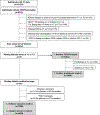Associations of changes in fat free mass with risk for type 2 diabetes: Hispanic Community Health Study/Study of Latinos
- PMID: 33242517
- PMCID: PMC8425264
- DOI: 10.1016/j.diabres.2020.108557
Associations of changes in fat free mass with risk for type 2 diabetes: Hispanic Community Health Study/Study of Latinos
Abstract
Aims: To determine whether loss of muscle mass (approximated using fat free mass [FFM]) is associated with risk for type 2 diabetes mellitus (T2DM) in Hispanic/Latino adults in the United States.
Methods: Participants were Hispanic/Latino adults (18-74-year-olds) who completed Visit 2 of the Hispanic Community Health Study/Study of Latinos (HCHS/SOL; multi-site, prospective cohort study; 6.1-year follow-up) and did not have T2DM at baseline (n = 6264). At baseline and Visit 2, FFM was measured using bioelectrical impedance analysis and fasting glucose, HbA1c, and fasting insulin were measured by examiners. Diabetes was defined according to American Diabetes Association criteria. Survey-weighted Poisson regression models examined the association of percent change in relative FFM (%ΔFFM) with incident prediabetes and T2DM. Survey-weighted multivariable regression models examined associations of %ΔFFM with changes in glucose and insulin measures.
Results: Relative FFM declined by 2.1% between visits. %ΔFFM was inversely associated with incident prediabetes (p-for-trend = 0.001) and with changes in glucose and insulin measures (p-for-trend <0.0001). Findings were null, except for HOMA-IR, after adjustment for changes in adiposity measures. Associations were generally stronger for individuals with baseline overweight/obesity.
Conclusions: Reducing loss of FFM during adulthood may reduce prediabetes risk (primarily insulin resistance), particularly among individuals with overweight/obesity.
Keywords: Adiposity; Hispanic; Prospective studies; Sarcopenia; Type 2 diabetes.
Copyright © 2020 Elsevier B.V. All rights reserved.
Conflict of interest statement
Declaration of Competing Interest The authors declare that they have no known competing financial interests or personal relationships that could have appeared to influence the work reported in this paper.
Figures


Similar articles
-
Association of Sugar-Sweetened Beverage Consumption with Prediabetes and Glucose Metabolism Markers in Hispanic/Latino Adults in the United States: Results from the Hispanic Community Health Study/Study of Latinos (HCHS/SOL).J Nutr. 2022 Jan 11;152(1):235-245. doi: 10.1093/jn/nxab334. J Nutr. 2022. PMID: 34558625 Free PMC article.
-
Association of glucose homeostasis measures with heart rate variability among Hispanic/Latino adults without diabetes: the Hispanic Community Health Study/Study of Latinos (HCHS/SOL).Cardiovasc Diabetol. 2016 Mar 16;15:45. doi: 10.1186/s12933-016-0364-y. Cardiovasc Diabetol. 2016. PMID: 26983644 Free PMC article.
-
IDENTIFYING PROBABLE DIABETES MELLITUS AMONG HISPANICS/LATINOS FROM FOUR U.S. CITIES: FINDINGS FROM THE HISPANIC COMMUNITY HEALTH STUDY/STUDY OF LATINOS.Endocr Pract. 2016 Oct;22(10):1151-1160. doi: 10.4158/EP151144.OR. Epub 2016 Jun 13. Endocr Pract. 2016. PMID: 27295013 Free PMC article.
-
Associations between avocado intake and measures of glucose and insulin homeostasis in Hispanic individuals with and without type 2 diabetes: Results from the Hispanic Community Health Study/Study of Latinos (HCHS/SOL).Nutr Metab Cardiovasc Dis. 2023 Dec;33(12):2428-2439. doi: 10.1016/j.numecd.2023.08.002. Epub 2023 Aug 18. Nutr Metab Cardiovasc Dis. 2023. PMID: 37798236 Free PMC article.
-
Association of Impaired Glucose Regulation and Insulin Resistance With Cardiac Structure and Function: Results From ECHO-SOL (Echocardiographic Study of Latinos).Circ Cardiovasc Imaging. 2016 Oct;9(10):e005032. doi: 10.1161/CIRCIMAGING.116.005032. Circ Cardiovasc Imaging. 2016. PMID: 27729362 Free PMC article.
Cited by
-
Bioelectrical Impedance Analysis for the Assessment of Body Composition in Sarcopenia and Type 2 Diabetes.Nutrients. 2022 Apr 29;14(9):1864. doi: 10.3390/nu14091864. Nutrients. 2022. PMID: 35565832 Free PMC article. Review.
-
Muscle strength and prediabetes progression and regression in middle-aged and older adults: a prospective cohort study.J Cachexia Sarcopenia Muscle. 2022 Apr;13(2):909-918. doi: 10.1002/jcsm.12905. Epub 2022 Jan 23. J Cachexia Sarcopenia Muscle. 2022. PMID: 35068089 Free PMC article.
-
Association between sarcopenia and prediabetes among non-elderly US adults.J Endocrinol Invest. 2023 Sep;46(9):1815-1824. doi: 10.1007/s40618-023-02038-y. Epub 2023 Mar 1. J Endocrinol Invest. 2023. PMID: 36856982
-
Obesity among Latinx people in the United States: A review.Obesity (Silver Spring). 2023 Feb;31(2):329-337. doi: 10.1002/oby.23638. Obesity (Silver Spring). 2023. PMID: 36695058 Free PMC article. Review.
-
Relationship of Fat Mass Index and Fat Free Mass Index With Body Mass Index and Association With Function, Cognition and Sarcopenia in Pre-Frail Older Adults.Front Endocrinol (Lausanne). 2021 Dec 24;12:765415. doi: 10.3389/fendo.2021.765415. eCollection 2021. Front Endocrinol (Lausanne). 2021. PMID: 35002957 Free PMC article.
References
-
- Centers for Disease Control and Prevention. National Diabetes Statistics Report, 2017. Atlanta, GA: Centers for Disease Control and Prevention, U.S. Dept of Health and Human Services; 2017.
-
- Baumgartner RN, Koehler KM, Gallagher D, Romero L, Heymsfield SB, Ross RR, et al.Epidemiology of sarcopenia among the elderly in New Mexico. Am J Epidemiol. 1998;147(8):755–63. - PubMed
MeSH terms
Grants and funding
LinkOut - more resources
Full Text Sources
Other Literature Sources
Medical

